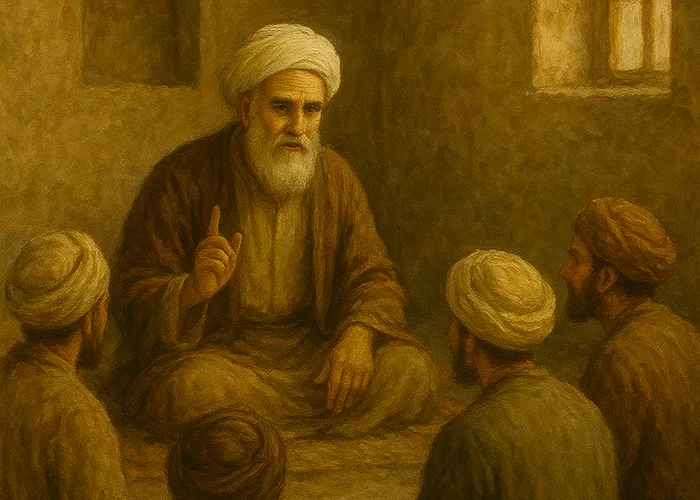Hujjat al-Islam Dr. Gholamhossein Adil
In this week’s Friday bulletin, we sat down with a media-savvy Friday prayer leader. A figure who, alongside his cultural and educational efforts and numerous authored and translated works, has harnessed media to advance the goals of Friday prayer. Hujjat al-Islam Dr. Gholamhossein Adil is a cultural and media activist based in the UK. His responses to our questions are insightful and can serve as a roadmap for Friday Imams navigating the digital age.
Question 1 – Could you please tell us about your cultural activities and the books you’ve authored?
I completed my seminary studies in Qom and have authored and translated over 50 books. Some notable examples include Ali in Sunni Books, Commentary on al-Sahifa al-Sajjadiyya, and Commentary on Du’a Kumayl, along with other supplications in Urdu and English.
One of my major accomplishments was founding the first Shi’a-oriented TV network in Europe and the UK, Hedayat TV, in 2009. The network has produced programs on various contemporary issues using high media standards, and—thanks be to God—it has been well-received.
In addition to my media work, I have founded several cultural centres, such as:
- Islamic Thought Publishing Centre in Pakistan
- Al-Sadiq Seminary in the UK
- Muhibban Zaynab Centre for Women
- Masumeen Charitable and Cultural Centre in Iran
- Muhibban al-Mahdi Youth Group
- Zainabiya Cultural and Educational Charity in Quetta, Pakistan
- Muhibban Hedayat Cultural and Charitable Network in the UK, Pakistan, Iran, and some European countries.
Our main audience consists of young British-born Muslims facing identity, cultural, and theological challenges. Additionally, students and non-Muslims interested in interfaith dialogue are among our audience.
I have also delivered short-term preaching missions in the United States (Detroit, Los Angeles), Canada, several European countries, Australia, New Zealand, Japan, Pakistan, and others.
Question 2 – Could you tell us about your Friday prayer leadership roles?
I have served as the Friday Imam at the Burnley Central Mosque, Bradford Hussainiya, and Al-Sadiq Academy in the UK.
Question 3 – What has been your most impactful activity in Friday prayer that received positive public response, and why?
A) Combining Dynamic Jurisprudence with Western Philosophy
- Applying philosophical methods to interpret the Qur’an and Hadith, especially when addressing youth-related questions—such as the relationship between freedom of speech in the West and the Islamic concept of hijab.
- Preparing khutbahs (sermons) tailored for seminary students and university audiences.
B) Focusing on the Social Issues of Migrants
- Addressing challenges such as intercultural marriages, alcohol among Muslim youth, and the role of women in mosques.
- Organizing Q&A sessions titled “Rationality and Shariah” alongside Friday prayers in Manchester.
C) Engaging in Critical Discourse
- Answering theological, philosophical, social, and human rights-related doubts.
- Critiquing secularism in sermons, drawing upon the views of philosophers like Charles Taylor and Alasdair MacIntyre.
D) Sermons on Fiqh al-Hayat fi al-Gharb (Jurisprudence of Life in the West)
In a series of sermons delivered at Bradford’s Friday prayers in 2015, I addressed the issue of interest (riba) in Western banking systems, integrating the views of Grand Ayatollahs Khamenei and Sistani.
Question 4 – What do you think contributed most to the public’s positive reception of your work?
I tried to avoid blindly imitating traditional styles. In Friday sermons, I used simple English to explain contemporary issues clearly. Broadcasting the sermons live on digital platforms allowed access to those unable to attend in person. I also delivered sermons in Urdu for migrants from Pakistan and India. Emphasizing Islamic unity—such as inviting Sunni guests to Friday prayers in Manchester—and distributing infographic pamphlets in English and Urdu also played key roles in audience engagement.
Question 5 – In your view, how much can Friday Imams utilize digital media to advance the goals of Friday prayer?
In short, Friday prayer in the West should act more like a social startup that addresses real-life problems. In a world dominated by social media and digital platforms, maintaining relevance as a religious leader in the West requires a smart redefinition of the relationship between tradition and modernity.
I believe the following strategies are key:
- Transforming traditional content into engaging digital packages
- Creating an interactive ecosystem between the mosque and digital space
- Personalizing content for different age groups
- Turning the audience from passive “consumers” into active content producers
- Maintaining authenticity while innovating
- Collaborating with universities and academic institutions
Thus, digital media is an unparalleled opportunity for Friday Imams today. In fact, using it is not a choice but a strategic necessity for engaging with the digital generation and influencing public discourse.
Based on my 40 years of experience in religious outreach in the West, the most important potentials and strategies include:
- Expanding reach beyond mosque geography through multilingual live streaming
- Producing short-form content
- Creating two-way engagement with audiences
- Countering ideological doubts and soft cultural warfare
- Teaching life skills through a religious lens
Networking with scholars and influencers
editor's pick
news via inbox
Subscribe to the newsletter.




